| Srl | Item |
| 1 |
ID:
161001
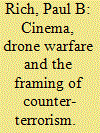

|
|
|
|
|
| Summary/Abstract |
The study of the cinematic representation is extremely useful in framing of counter-terrorism policies, whether in the US or elsewhere. This paper examines cinema’s interest in drone warfare as well as the lives and personalities of drone pilots. It argues that drone warfare suffers a considerable image problem that has been brought out in several recent features and it is unlikely that any major cinematic myth of drone warfare will easily develop, certainly in comparison to myths concerning special forces and special operations.
|
|
|
|
|
|
|
|
|
|
|
|
|
|
|
|
| 2 |
ID:
160998
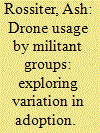

|
|
|
|
|
| Summary/Abstract |
Judging by recent media reporting and pronouncements by senior US military and security officials, the use of drones by militant groups is both reshaping conflict between armed non-state actors and state parties and now presents a grave and direct threat to nations in the West and elsewhere. But does this threat warrant the attention it is currently receiving? To answer this question, this article surveys how various militant groups have used drones both tactically on the battlefield and for wider strategic purposes. Closely examining how drones have been employed and by whom provides a basis for understanding variation in adoption. The article shows how drone usage or non-usage is highly contingent on the setting of the conflict, the aims of different groups, and the capacity of groups to adopt the technology. Though advances in drone technology could make the use-case more appealing for militant groups, drones will be subject to the same back-and-forth, techno-tactical adaptation dynamic between adversaries that have accompanied prior military innovations.
|
|
|
|
|
|
|
|
|
|
|
|
|
|
|
|
| 3 |
ID:
161002


|
|
|
|
|
| Summary/Abstract |
The post-communist countries transition from the Warsaw Pact style of platforms and systems to Western-compatible capabilities has never been an easy task or a process without conflicts. This was no different for the Visegrád countries either, in which case the Hungarian Gripen procurement stands out. After much debate, Budapest decided to modernize its fighter fleet with the not battle tested Swedish-made Gripen fighter aircraft. This decision received several critiques due to the lack of transparency in the selection process and the initial lack of NATO-required systems. Subsequently, the fleet has had to operate in a financially demanding environment. Moreover, the air force has lost two aircrafts in accidents. Now that the jets are in the middle of their envisaged life cycle, it is more than appropriate to answer the question if the Gripens can utilize their full combat potential or will they fail the test of time?
|
|
|
|
|
|
|
|
|
|
|
|
|
|
|
|
| 4 |
ID:
161005
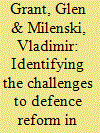

|
|
|
|
|
| Summary/Abstract |
The authors have over 50 years' experience of working on defence in Central and Eastern Europe. They have been intimately involved in trying to reform over 10 national defence organisations including Ukraine. During this work, they often faced intractable resistance and scepticism or conversely, apparent unbounded support, but following this, a complete lack of any actual implementation work by officials. This paper addresses some of the findings and observations identified by the authors that appear to cause these responses and the consequent failure of reform. A new research approach has been taken by using the business and culture tools from Schein, Hofstede and Kotter to try and unravel the underlying causality of that failure. The second part of the paper produces a new process for change based upon the research conclusions to help other advisers and consultants working on reform in the post communist defence arena.
|
|
|
|
|
|
|
|
|
|
|
|
|
|
|
|
| 5 |
ID:
160999
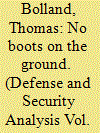

|
|
|
|
|
| Summary/Abstract |
The number of US drone strikes against Al Qaeda in the Arabian Peninsula (AQAP) in Yemen has increased significantly since 2010, but received limited academic attention. This article examines the effectiveness of this drone campaign using an existing theoretical framework. Crucially, we contribute to the framework by adding a fourth intervening variable, namely target correspondence. Through a single case study, it is found that drones have only enjoyed limited success in degrading AQAP's hierarchical structure, qualified human resources and access to key material resources, and in some cases – owing to our target correspondence analysis – this limited success has come at a price. It is found that drones have temporarily disrupted AQAP by successfully eliminating senior leaders involved in coordinating and overseeing external operations. Overall, AQAP's ability to hit Western targets remains significant.
|
|
|
|
|
|
|
|
|
|
|
|
|
|
|
|
| 6 |
ID:
161004
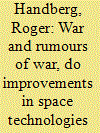

|
|
|
|
|
| Summary/Abstract |
Combat in near-Earth orbit is emerging as a more realistic possibility. The argument here is that changes in space technologies combined with a sea change in political rhetoric is bringing the possibility of military conflict in space technologies. This movement reflects a generational shift as the original decisions regarding military conflict in space are now being reassessed by a generation who did not experience World War II or the Cold War. For these, the sanctuary approach to space activities is not as persuasive and new enhanced space technologies bring the possibility of victory or at least survival possible during a conflict in space.
|
|
|
|
|
|
|
|
|
|
|
|
|
|
|
|